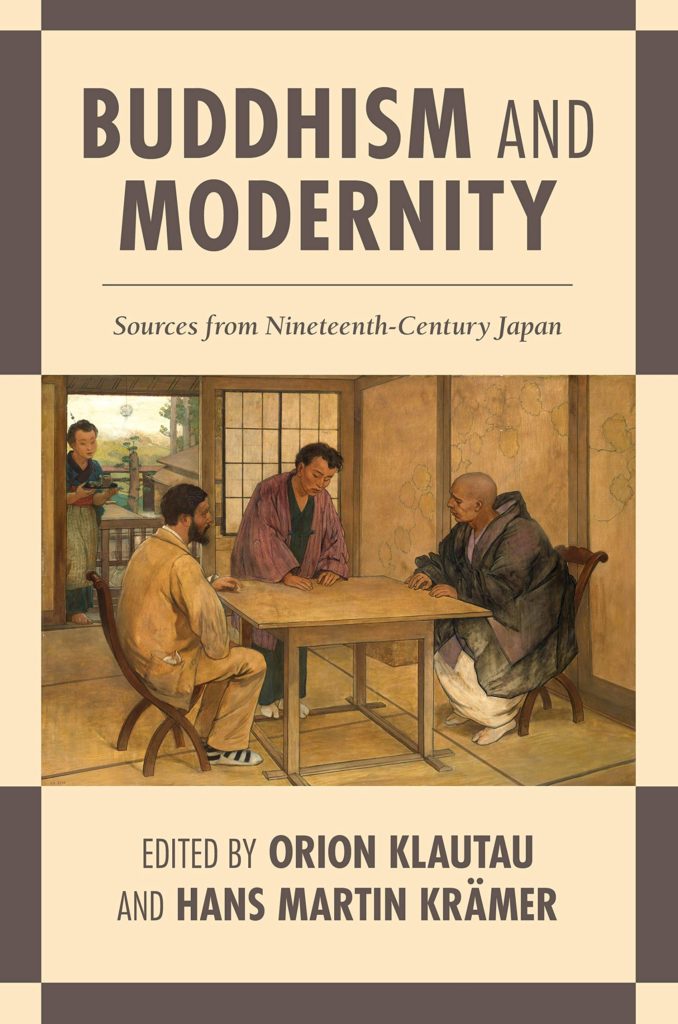Review by Chad Kohalyk
The rapid modernization of Japan after the Meiji Restoration is often expressed in kilometres of railway laid down, or number of telegraph lines strung up. But there was also a spiritual revolution happening: Japanese Buddhism in the Meiji Period (1868-1912) was in crisis. Changing laws revoked state privileges for Buddhist institutions and prioritized a new “national Shintō,” which disrupted the delicate balance between Buddhism and Shinto that had evolved over a millennium and a half. Soon a ban on Christianity—instated in 1637 and which provided the genesis for Japan’s policy to cut itself off from the West—was lifted, and Christian missionaries were once again able to grow their flock in Japan. Elites looking to modernize were filled with their own secular zeal. Crisis for some was opportunity for others.
Buddhism and Modernity: Sources from Nineteenth-Century Japan, (U. of Hawaii Press, Oct. 2021) edited by Orion Klautau and Hans Martin Krämer, gives us insight into how some prominent Buddhist thinkers of the era analyzed, criticized, and sometimes justified the momentous transformation underway. The book contains essays and excerpts from 1856 to 1912, divided into five interlocking sections representing some of the major challenges for Japanese Buddhism during its modernization including: the religion’s role in nation-building, sectarian reform, science and philosophy, social reform, and the relationship between Japan and Asia.
Buddhism and Modernity is a snapshot of influential Buddhist voices during the nineteenth century, but also offers analysis from leading English-language scholars of Japanese religion in the twenty-first century. Each chapter contains an introduction where the translator provides key information for the reader to understand the context of the essay. Chapters range across topics from clerical marriage, women’s education, ardent critiques of Christianity, to proposals on how to organize Buddhists. Although each introduces a new perspective, common themes thread them together. Often we see the Buddhist intellectual elite struggling to adopt some parts of modernity while rejecting others.
This collection provides an excellent counterbalance to the popular English-language writings of the era from famous monks such as Shaku Soyen—who introduced Zen to the United States through translations by his student DT Suzuki. Such texts tended to tailor Buddhism to Protestant Christian sensibilities. This is in contrast to the writings in Buddhism and Modernity which were written for Japanese audiences: politicians, Buddhist scholars and the wider public.
With the threat of Christian proselytism constantly looming, and Japan’s national goal of re-entering the international community, the story of Japanese Buddhist modernism is an international one. However, the book keeps its focus on the domestic story of building the new nation of Japan.
In the final section on Japan and Asia, the international outlook of some Japanese Buddhist priests are highlighted, including Ogurusu Kōchō, the first known Buddhist priest to travel to China in the modern period. In 1873 Ogurusu instigated “a plan to protect the Dharma” involving a team-up between India, China, and Japan to rise up against the imperialist West. However, as translator Erik Schicketanz notes “Anti-colonial solidarities could transform rather easily into ideological support for imperialism,” an attitude particularly palpable in Shaku Sōen’s essay, “The Japanese People’s Spirit.” In this essay, Sōen sites a “questionable rhetoric used by a Zen priest within the context of Japanese expansion into East Asia.”
Kawaguchi Ekai’s legendary trip to Tibet in 1903 can be seen in a clearer light thanks to the final chapter of the book which carefully translates the “Characteristics of the Three Races” section of Kawaguchi’s famous travelogue. Reading his descriptions of the Tibetans, Khampas, and Mongolians in his own words reveals that his commentary was not merely “lowbrow” but racist, an aspect obscured in the English-language edition of 1909 by the particularly euphemism-driven British translators of the time. How these writers and intellectuals of the time conveyed their thoughts in their own language gives us a peek behind the curtain and is what makes this source book so valuable to scholars who may be unable to read older forms of the Japanese language.
It is argued that translated works should be valued much more in academia than they currently are. I certainly agree with that argument, as translations unlock primary sources for the wider scholarly community. I would also extend the argument to include periodically returning to primary sources with a modern, more critical eye—another of this book’s contributions to the field.


